Egypt’s Sinai Bedouins fear Israel’s mass displacement of Gaza Palestinians
Bedouin tribes in Sinai have long taken a hit from geopolitical conflicts. Now, concerns are rising again.
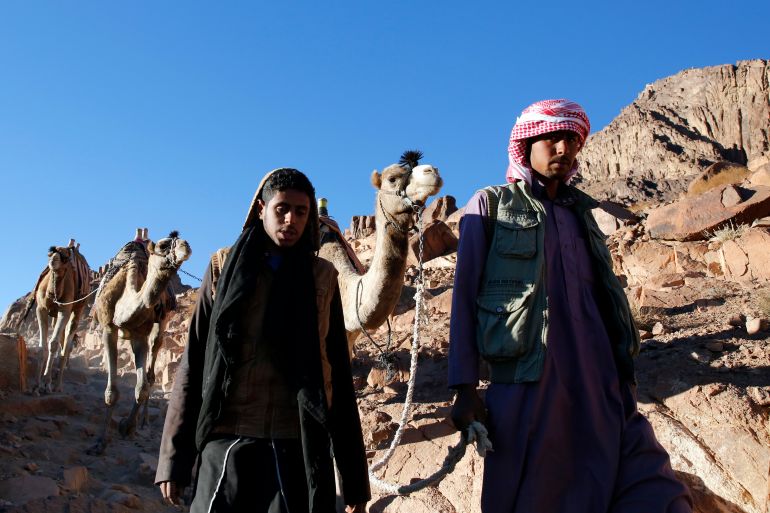
As Israel’s war on Gaza nears the end of a second month, Rehab Eldalil worries about reports of efforts by Israel to push the 2.3 million people of the besieged Gaza Strip into the Egyptian Sinai Peninsula – her ancestors’ home.
President Abdel Fattah el-Sisi has publicly stated that Egypt will not allow a displacement of Palestinians, as it would mean “the end of the Palestinian cause” and a potential threat to Egypt’s national security. But news reports have suggested that Israel might offer to pay off some of Egypt’s vast public debt in exchange for allowing the forced displacement of people from Gaza into Sinai.
Keep reading
list of 4 itemsIsraeli air strike destroys residential tower in Gaza
Hamas heads to Cairo, Blinken in Riyadh in push for Gaza truce
Will it be safe for Palestinians in Gaza to return and rebuild their homes?
Eldalil, an Egyptian photographer and storyteller of Bedouin descent, worries that that kind of narrative “takes away the right of Palestinians to stay on their land, while promoting that Sinai is an empty desert for Palestinians to go to”.
It is not, and hasn’t been for centuries.
The 61,000sq km (23,500sq mile) triangle of land that bridges Africa and Asia is a popular tourist destination, a significant religious and historical site, and an important economic centre for Egypt. It is home to several oil and natural gas fields, as well as the Suez Canal, one of the world’s busiest shipping routes, which generates up to $9bn annually.
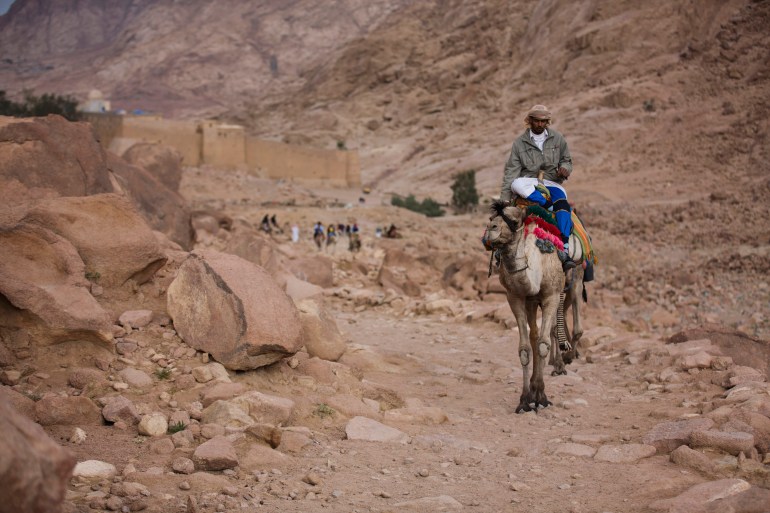
The peninsula, its northern two-thirds taken up by the Sinai Desert and the mountainous south boasting St Catherine, Egypt’s highest peak, has also long been home to myriad Bedouin tribes, who lived according to their traditions for centuries, some eventually settling into towns.
These communities have often been neglected by the authorities, and have been collateral damage in national or regional geopolitical conflicts. Now, the war on Gaza is raising fears for Bedouins.
Sinai’s first natives
Before colonial powers drew borders to create the countries in the region today, the Arabian Peninsula, the Levant and North Africa were linked by merchant routes that offered the region a common language. The vectors of this phenomenon were the Bedouin Arab tribes.
Eventually, Eldalil says, “These communities … they stopped being nomads, they settled as the first natives of this desert over 1,000 years ago,” something she would hear from the elders of her tribe, the Jabaliya (people from the mountain).
“At the beginning, they split the Peninsula into seven major tribes,” she says, which have now developed into a total of 33, according to experts.
Eldalil, who has several visual projects about Bedouin identity and heritage, says the legacy of these original tribes is still alive.
“Embroidery is a huge tradition that the community still practices, as well as Bedouin traditional poetry, where they get to tell their stories,” she says.
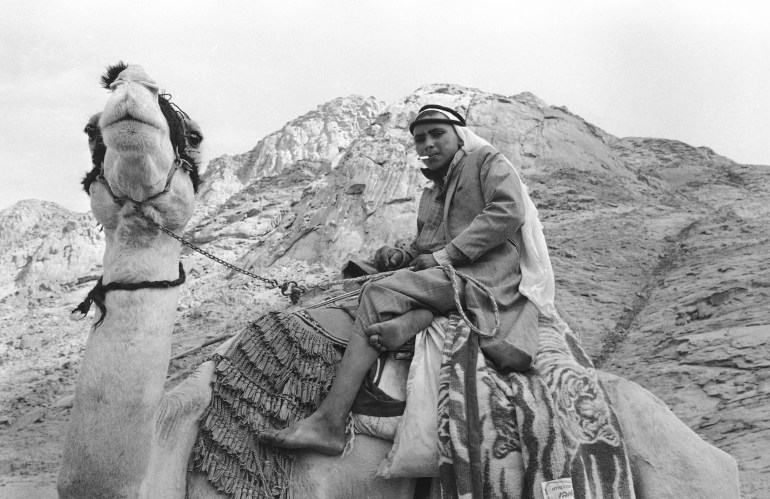
And there is the Bedouin law. “If there is an issue… they would have a sit-down between the families in dispute and fix it in a more civilised manner that you would see in many progressive countries,” she says.
“They have their own set of rules and unspoken laws, something that with time has created a lot of issues between them and the government, just like it happens with any other indigenous community in the world,” Eldalil adds.
Their deep connection to the land has added to those tensions with the authorities, she says. “They are able to walk for days and weeks within the desert, they know every inch of sand and corner of the mountains. They know their land so well that it becomes intimidating, and there arises a need to control them.”
Dealing with Israel
Scholar Hilary Gilbert says Bedouins have an “environmental identity”, based on her decades of research into Bedouin life.
“They see themselves as being an integral part of the natural world, and so they see themselves very much as its guardians,” the University of Nottingham research fellow in anthropology and development added.
Many of these “guardians of the natural world” refused to leave their land when Israel invaded the Sinai Peninsula in 1967, an occupation that lasted 15 years, leading to a lot of suspicion directed towards them from many non-Sinai Egyptians, Gilbert said. “A popular belief was that Bedouins were collaborating with the Israelis, an ingrained prejudice against them on the basis that they’re different, uncultivated and untrustworthy,” she added.
“When Israel left and the Egyptians took over the government again, they adopted a sort of policy of benign neglect of the Bedouins.”
For years, Bedouins found it hard to access their rights as citizens. National identity cards and paperwork were nearly impossible to come by, schools, hospitals and public services were scarce, and entering the army was forbidden.
When Sinai was “discovered” in the late 1980s as a region that could make Egypt a tourism revenue, the Bedouins who lived there did not benefit – in fact, they found themselves displaced and disadvantaged, according to Eldalil.
During 2011’s Arab Spring, the Rafah crossing between Egypt and Gaza became a path for armed fighters and weapons transit, bringing the Sinai Bedouins under increased scrutiny from the Egyptian state. Around the same time, the rise of armed groups like ISIL(ISIS)-affiliated Ansar Bayt al-Maqdis deepened the Egyptian government’s security concerns in Sinai.
When current President Abdel Fatah el-Sisi took power in 2013, he launched a campaign against armed groups in the Sinai. That included the creation of a 79km (49-mile) buffer zone in North Sinai, along the border with the Gaza Strip, in 2014.
To do that, his forces demolished more than 3,255 residential, commercial and administrative buildings between 2013 and 2015, and forcefully evicted thousands of people, according to a Human Rights Watch report.
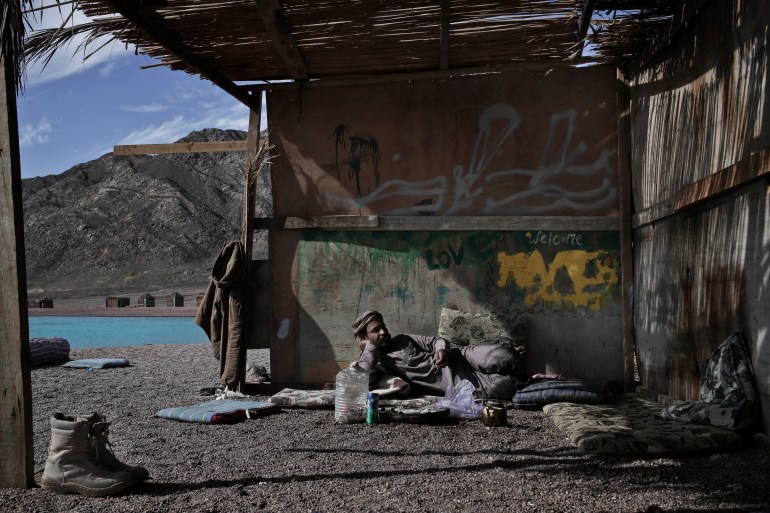
“My father’s home became sort of a desert,” says Eldalil, whose father used to live in North Sinai. “All the homes next to him have been deserted because of the campaign to fight terrorism.”
Those forced to leave by the army dispersed to a number of Egyptian cities, including al-Arish, Ismailia and Sharqiya, west of the Suez Canal. They were promised that their eviction would be short, only until the “elimination of terrorism”, local sources told Al Jazeera.
However, these communities are still displaced, although the Egyptian government has changed its approach towards the Bedouins since 2018 by allying with different tribes to collaborate on intelligence and security in Sinai.
In August, some of these Bedouins held a 48-hour sit-in in the southern area of Sheikh Zuweid, demanding the right to return to their lands. Followed by promises from the authorities that returns would begin on October 20, the sit-in was dissolved.
With the mounting security concerns around the Rafah crossing since the hostilities in Gaza started on October 7, local Egyptian authorities seem to have changed their minds.
“The moment came and it was not time to return,” a member of these Bedouin communities tells Al Jazeera.
“In October, dozens of people from the Sawarka and Rumailat tribes gathered again […] but members of the armed forces dispersed the gathering and arrested a number of young people.”
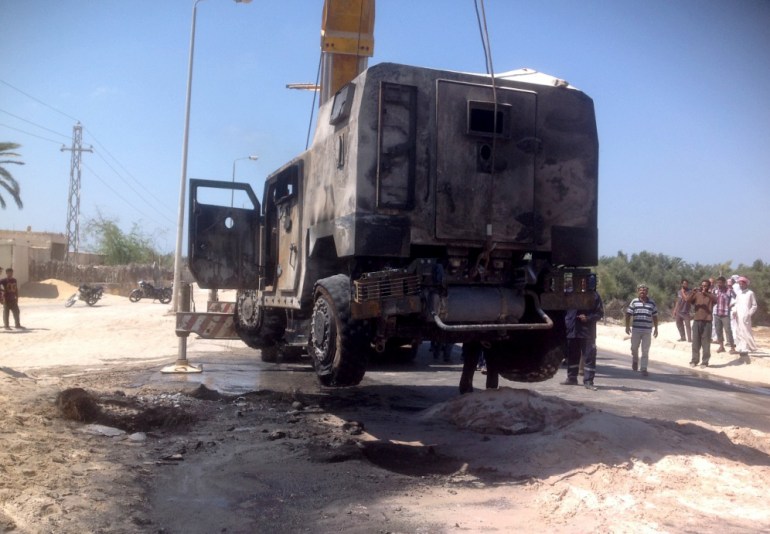
Some organisations that work with refugees began to welcome Bedouins too, in cities like Cairo and Alexandria.
‘Protecting their land’
“The government could easily cooperate with the communities, understand more about the land, about the landscape and how to manage it,” says Eldalil. “After all, protecting their land is one of the biggest sources of pride for Indigenous peoples.”
This is a sentiment shared by Palestinians who already live in Sinai.
Mohammed* is one of the thousands of Palestinians who were born and raised in the Sinai after the mass expulsion of Palestinians during the creation of Israel in 1948, or the Nakba, Arabic for catastrophe.
“Palestinians in North Sinai make up more than one-third of the population, and even if some of us are still unable to get our Egyptian citizenship because of strict laws, we are treated as Egyptians,” Mohammed says. “Us and Bedouins are the same people, have the same blood.”
Bedouins in Sinai, he says, have been helping Palestinians who were stuck in the desert when the current war started, and have been volunteering to provide relief to injured Palestinians coming from Gaza since the partial opening of the Rafah crossing in early November.
Now, as fears mount that a forced exodus of people from Gaza into Sinai could, in turn, displace local communities, Eldalil hopes the government will continue to nurture the relationship between Cairo and the Bedouins of Sinai.
“There are in fact people inhabiting Sinai: the Bedouin communities,” she says, “who also have the right to remain on their land, just like the Palestinians”.
*Name changed at the person’s request to protect their identity.